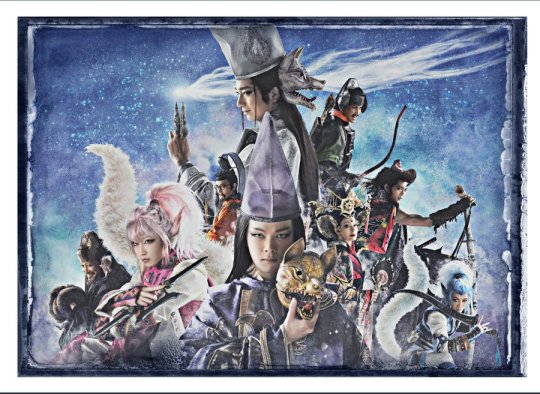#muraki yoshiko
Explore tagged Tumblr posts
Photo

Jinpachi Nezu and Mieko Harada in Ran (Akira Kurosawa, 1985) Cast: Tatsuya Nakadai, Akira Terao, Jinpachi Nezu, Daisuke Ryo, Mieko Harada, Yoshiko Miyazaki, Hisashi Igawa, Pîtâ, Masayuki Yui. Screenplay: Akira Kurosawa, Hideo Oguni, Masato Ide, based on a play by William Shakespeare. Cinematography: Asakazu Nakai, Takao Saito, Shoji Ueda. Production design: Shinobu Muraki, Yoshiro Muraki. Film editing: Akira Kurosawa. Music: Toru Takemitsu. Costume design: Emi Wada. Lavish in color and pattern, Ran may be Akira Kurosawa's most pictorial film, to the point that the images and costumes and sets sometimes threaten to overwhelm the human drama at its core. This is Kurosawa's second effort at translating a Shakespeare play into medieval Japanese terms, and I prefer his adaptation of Macbeth, the 1957 Throne of Blood, to this reworking of King Lear. It seems to me that in Ran, Kurosawa stumbles over the analogous figures from Shakespeare in ways that he doesn't in his earlier film. Turning Lear's daughters into Hidetora's sons robs much of the delicacy and painful sadness of the Shakespeare play, especially in the final reunion of Lear and Cordelia. And King Lear is a more complex play than Macbeth, with its intricate subplot involving Gloucester and his sons, and the multiple intrigues of the households of Goneril and Regan. Kurosawa has pared down and fused some of these secondary stories, but he still loses sight at times of his central figure, the Lear analog, Lord Hidetora. Tatsuya Nakadai is unquestionably one of the world's great film actors, but he's too sturdy a figure for the enfeebled Hidetora, and the stylized old-age makeup often hides his features -- except for the great, glaring eyes. There are grand things, however, in the film, including a wonderfully villainous performance by Mieko Harada as the Lady Kaede, and a curiously effective Fool, performed by the androgynous actor-dancer known as Pîtâ.
6 notes
·
View notes
Photo

[Announcement] 2021年劇団☆新感線 41周年興行 秋公演 いのうえ歌舞伎「狐晴明九尾狩」(2021nen gekidan☆shinkansen 41shuunen kougzou aki kouen inoue kabuki kitsune seimei kyuubigari)
the show will be running from September 17th, 2021 to October 17th, 2021 (Tokyo) @ TBS 赤坂 ACT シアタ�� (TBS Akasaka ACT Theater) & October 27th, 2021 to November 11th, 2021 (Osaka) @ オリックス劇場 (Orix Theater)
youtube
Cast:
Nakamura Tomoya Yoshioka Riho Asari Yousuke Ryuusei Ryou Saotome Yuuki Chiba Tetsuya Takada Shouka Awane Makoto Mukai Osamu Ukon Kenichi Kouno Masato Sakagi Keiichirou Muraki Yoshiko Indie Takahashi Yamamoto Kanako Isono Shingo Yoshida Metal Nakatani Satomi Hosaka Ema Muraki Jin Kawahara Masatsugu Takeda Kouji
homepage natalie
#狐晴明九尾狩#kitsune seimei kyuubigari#中村倫也#nakamura tomoya#吉岡里帆#yoshioka riho#浅利陽介#asari yousuke#竜星涼#ryuusei ryou#早乙女友貴#saotome yuuki#千葉哲也#chiba tetsuya#高田聖子#takada shouka#粟根まこと#awane makoto#向井理#mukai osamu#右近健一#ukon kenichi#河野まさと#kouno masato#逆木圭一郎#sakagi keiichirou#村木よし子#muraki yoshiko#インディ高橋#indie takahashi
5 notes
·
View notes
Photo

Yoshiko Sakuma, Sayuri Yoshinaga, Yûko Kotegawa, and Keiko Kishi in The Makioka Sisters (Kon Ichikawa, 1983)
Cast: Yoshiko Sakuma, Sayuri Yoshinaga, Yûko Kotegawa, Juzo Itami, Keiko Kishi, Yonedanji Katsura. Screenplay: Shin’ya Hidaka, Kon Ichikawa, based on a novel by Jun’ichiro Tanizaki. Cinematography: Kiyoshi Hasegawa. Production design: Shinobu Muraki. Film editing: Chizuko Osada. Music: Shinnosuke Osawa, Toshiyuki Watanabe.
Lovers of romantic historical costume dramas like the Merchant Ivory movies and the flood of Jane Austen adaptations will find much that's familiar in Kon Ichikawa's The Makioka Sisters. The lushly melancholy scene at the beginning of the film, in which the sisters walk through the blossoming cherry orchards in Kyoto, accompanied by an instrumental arrangement of Handel's aria "Ombra mai fu" from Serse, anticipates by two years the scenes in Tuscany in the Merchant Ivory version of E.M. Forster's A Room With a View (James Ivory, 1985) that are set to music like Puccini's "O mio babbino caro" and "Chi il bel sogno di Doretta." The plot consists of finding a husband for one of the sisters, Yukiko (Sayuri Yoshinaga), whose marital prospects are endangered by the unconventional behavior of her younger sister, Taeko (Yuko Kotegawa), just as Jane and Elizabeth Bennet's were by the scandalous behavior of their sister, Lydia, in Pride and Prejudice. And just as Austen's novels took place against the distant background of the Napoleonic wars, so do the Japanese military incursions into China -- the film begins in the spring of 1938 -- recede into the background of the domestic problems of the Makioka sisters. There are four Makioka sisters, the proud remnants of a family whose male line has died out, but the husbands of the two oldest sisters, Tsuruko (Keiko Kishi) and Sachiko (Yoshiko Sakuma), have adopted the family name and are helping rebuild its fortunes. The sisters adhere to the family tradition that older sisters must marry before younger, which Taeko, the youngest, rebels against. As the film begins, she has already tried to elope with the irresponsible Okuhata (Yonedanji Katsura), and although the family thwarted that attempt, the story made it into the newspapers, which incorrectly reported Yukiko as the one who tried to elope. The family demands a retraction, but the newspaper only issues a correction. Yukiko is beautiful but shy, and attempts by a matchmaker to arrange a marriage for her have fallen through. There is a wonderful scene in which the family goes to meet a suitor, who turns out to be a terrible but funny bore. Ichikawa, who co-wrote the screenplay with Shinya Hidaka, develops and individualizes the characters of the sisters and their husbands well, and stays just this side of romantic sentimentality. The cinematography by Kiyoshi Hasegawa makes the most of the colorful settings -- spring cherry blossoms and autumn foliage -- and especially the beautiful costumes of Keiko Harada and Ikuko Murakami. Only occasionally does the note intrude that this is an ephemeral world, soon to be swept away by war.
1 note
·
View note